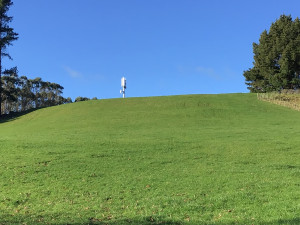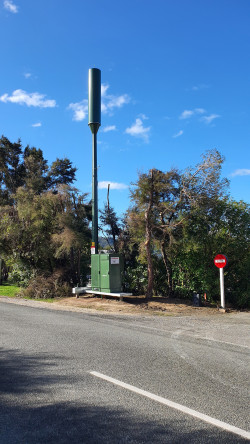Case study: Targeted solutions in the isolated reaches of ranges
Isolated parts of the country present some of the greatest challenges to providing broadband and mobile coverage.
On this page
Rugged terrain and extreme weather are more expected in these areas, but over the past two and a half years, COVID-19 lockdowns and related resource and supply-chain issues have posed additional difficulties. Even so, progress on both RBI2 and MBSF initiatives are running to schedule.
Ōtaki Gorge
 Ōtaki Gorge’s new tower under the RBI2 programme is a prime example of the government and private sector working together to come up with a targeted solution.
Ōtaki Gorge’s new tower under the RBI2 programme is a prime example of the government and private sector working together to come up with a targeted solution.
The new cell tower came online in June 2022 to provide broadband coverage for 80 households, as well as one of the main entrances to the tramping, hunting and walking opportunities in the wild landscape of the Tararua Forest Park.
The difference these connectivity upgrades can make for a community should not be underestimated.
Ōtaki Gorge resident Andrew Collins said of the new tower, that he is excited not only to know that mobile phone coverage has been vastly improved for the community but also that many will now receive broadband internet services. Andrew also says “the signal that now extends up the Gorge itself potentially could save the lives of those who come unstuck whilst tramping up there, and with improved coverage throughout the entire community the ability to be able to call emergency services has significantly increased.”
The Rural Connectivity Group (RCG) is an independent entity jointly owned by Spark, Vodafone and 2degrees, appointed by the government to be the provider for shared infrastructure under the RBI2 and MBSF.
The three mobile network operators share radio access network (RAN) equipment and one set of antennae on each facility built. As a world first, this unique funding and shared-cost model addresses some of the commercial barriers and enables modern digital services to be delivered further into isolated and rural parts of New Zealand.
Innovative solutions to tricky site locations require collaborative engagement with many stakeholders including local interested communities, landowners, councils, iwi and hapū representatives, engineers, archaeologists, Heritage NZ and Department of Conservation (DOC).
Marahau
A karakia marked the start of construction for a new cell site in Marahau. The blessing was led by Ihaka Griffin-Matthews (Ngāti Rārua, Ngāti Koata, Ngāti Tama, Te Ati Awa, Ngāti Toa, Ngāti Kuia, Rangitāne
ki Wairau, Ngāti Apa ki te Rā Tō), with representatives from Te Rūnanga o Ngāti Rārua, Te Ātiawa Manawhenua Ki Te Tau Ihu Trust, Wakatū Incorporation, local community and business stakeholders, Tasman District Council elected members, RCG and members of the build team involved in the construction of the site.
The new facility in Marahau will deliver reliable 4G wireless broadband and voice calling services to local homes, businesses, and visitors to the settlement of Marahau, as well as to the entrance of Abel Tasman National Park, the launch point for popular activities such as tramping and kayaking.
 “In the aftermath of Cyclone Gita and the subsequent civil defence emergency response, the community called for better and more resilient telecommunications should they be faced with a similar situation,” says RCG Chief Executive John Proctor.
“In the aftermath of Cyclone Gita and the subsequent civil defence emergency response, the community called for better and more resilient telecommunications should they be faced with a similar situation,” says RCG Chief Executive John Proctor.
"The need for up-to-date communication services is critical to support the future of our region. This new telecommunications network will have far-reaching benefits, supporting our local families, businesses, DOC, and emergency service teams along the National Park coastline. Daily life in Marahau will be enhanced when the cell site is switched on, providing access to online services, and it will help local businesses cater to the returning international visitor sector and support DOC to champion their ecological initiatives,” says Motueka Ward Councillor David Ogilvie.
The Marahau site will join 17 connectivity sites already live across the Tasman District, currently providing access to services for over 700 local households, 60km of state highway and four tourist locations, previously with poor, or no network connectivity.

